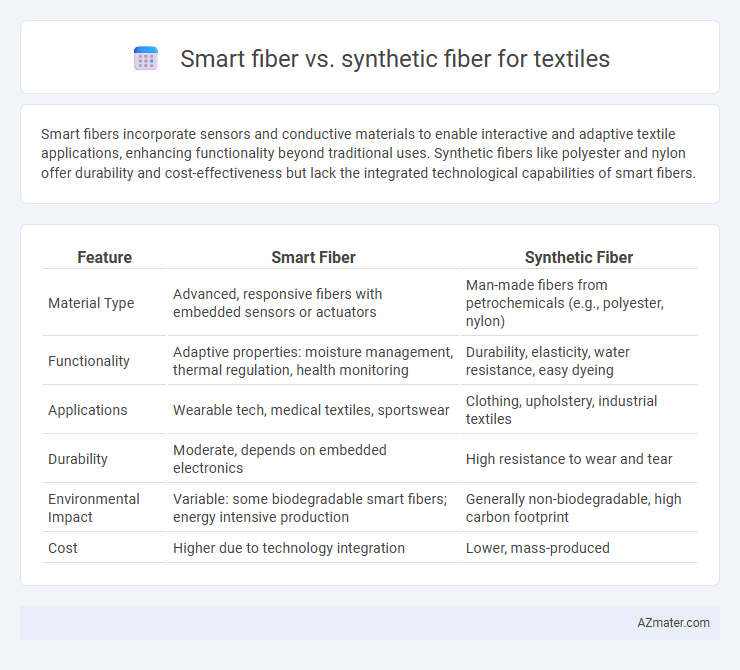Smart fibers incorporate sensors and conductive materials to enable interactive and adaptive textile applications, enhancing functionality beyond traditional uses. Synthetic fibers like polyester and nylon offer durability and cost-effectiveness but lack the integrated technological capabilities of smart fibers.
Table of Comparison
| Feature | Smart Fiber | Synthetic Fiber |
|---|---|---|
| Material Type | Advanced, responsive fibers with embedded sensors or actuators | Man-made fibers from petrochemicals (e.g., polyester, nylon) |
| Functionality | Adaptive properties: moisture management, thermal regulation, health monitoring | Durability, elasticity, water resistance, easy dyeing |
| Applications | Wearable tech, medical textiles, sportswear | Clothing, upholstery, industrial textiles |
| Durability | Moderate, depends on embedded electronics | High resistance to wear and tear |
| Environmental Impact | Variable: some biodegradable smart fibers; energy intensive production | Generally non-biodegradable, high carbon footprint |
| Cost | Higher due to technology integration | Lower, mass-produced |
Introduction to Smart Fibers and Synthetic Fibers
Smart fibers incorporate advanced materials and sensors enabling responsiveness to environmental stimuli such as temperature, light, or moisture, revolutionizing textile functionality. Synthetic fibers, produced from petrochemical polymers like nylon, polyester, and acrylic, offer durability, elasticity, and cost-efficiency, dominating the textile market due to their versatile applications. The integration of smart fibers in textiles enhances performance and user experience, while synthetic fibers provide foundational structural properties essential for everyday fabric use.
Key Definitions: Smart Fibers vs Synthetic Fibers
Smart fibers are advanced textile materials that respond dynamically to environmental stimuli such as temperature, light, or pressure, enabling adaptive functionality in garments and technical applications. Synthetic fibers, including polyester, nylon, and acrylic, are man-made fibers produced from petrochemicals designed primarily for durability, elasticity, and resistance to moisture. The fundamental distinction lies in smart fibers' ability to interact actively with their surroundings, while synthetic fibers provide consistent, engineered performance without adaptive properties.
Composition and Manufacturing Processes
Smart fibers, often embedded with sensors or conductive materials, incorporate advanced polymers like conductive polymers, carbon nanotubes, or shape-memory alloys, enabling responsive textile properties. Synthetic fibers, such as polyester, nylon, and acrylic, are primarily petroleum-based polymers produced through processes like polymerization and extrusion, resulting in uniform, durable fibers. Manufacturing smart fibers involves complex integration of electronic or chemical functionalities during or post-spinning, contrasting with the straightforward melt or solution spinning techniques typical of synthetic fiber production.
Functional Properties and Performance
Smart fibers in textiles offer advanced functional properties such as responsiveness to environmental stimuli, including temperature, moisture, and UV exposure, enabling adaptive comfort and enhanced wearer experience. Synthetic fibers, like polyester or nylon, provide consistent performance with high durability, moisture-wicking capabilities, and resistance to shrinking and stretching, making them suitable for mass production and varied applications. Smart fibers outperform conventional synthetics in dynamic functions such as self-cleaning, antimicrobial activity, and energy harvesting, contributing to innovative textile solutions in sportswear, medical textiles, and wearable technology.
Applications in Textile Industry
Smart fibers in the textile industry offer advanced functionalities such as moisture management, temperature regulation, and real-time health monitoring, enhancing performance in sportswear, medical textiles, and wearable technology. Synthetic fibers like polyester, nylon, and acrylic provide durability, elasticity, and resistance to chemicals, making them ideal for everyday apparel, industrial fabrics, and upholstery. The integration of smart fibers in textiles is revolutionizing applications by combining comfort with intelligence, while synthetic fibers remain essential for cost-effective, versatile fabric production.
Environmental Impact and Sustainability
Smart fibers in textiles, often engineered for biodegradability and energy efficiency, offer a promising solution for reducing environmental impact compared to traditional synthetic fibers such as polyester and nylon, which are derived from non-renewable petroleum resources and contribute significantly to microplastic pollution. Synthetic fibers are generally non-biodegradable, leading to persistent waste in landfills and oceans, whereas smart fibers incorporate eco-friendly materials and innovative production techniques to minimize carbon footprint and resource consumption. Textile manufacturers increasingly prioritize smart fibers that support circular economy principles, enhancing sustainability by enabling recyclability and decreasing dependency on fossil fuels.
Cost Comparison and Market Trends
Smart fibers, incorporating advanced materials like phase-change and conductive polymers, typically present higher initial costs compared to synthetic fibers such as polyester and nylon, which benefit from mass production economies. Market trends reveal growing demand for smart fibers in high-tech and wearable textiles, driving innovation and gradual price reductions, while synthetic fibers maintain dominance due to affordability and widespread industrial use. Investment in smart fiber technology is expanding rapidly with applications in health monitoring and adaptive clothing, suggesting a shift towards value-driven cost efficiency alongside traditional synthetic fibers.
Advantages of Smart Fibers Over Synthetic Fibers
Smart fibers enhance textile functionality by incorporating sensors and actuators, enabling real-time monitoring of environmental conditions and user health, which synthetic fibers lack. These fibers improve comfort and performance through adaptive properties like moisture regulation and temperature control, surpassing the static nature of traditional synthetic materials. Integration of smart fibers in textiles leads to innovative applications in sportswear, medical devices, and wearable technology, offering superior user experience and value.
Limitations and Challenges
Smart fibers in textiles face limitations such as high production costs, complex manufacturing processes, and integration challenges with existing textile machinery. Synthetic fibers often encounter environmental concerns due to non-biodegradability and reliance on petrochemical resources, alongside issues like microfiber pollution during washing. Both fiber types struggle with durability under regular wear and difficulty in achieving consistent performance in diverse applications.
Future Prospects in Textile Innovation
Smart fibers, embedded with sensors and responsive materials, offer dynamic functionalities such as temperature regulation, health monitoring, and environmental adaptation, positioning them as pivotal in future textile innovation. Synthetic fibers, known for durability, moisture-wicking properties, and cost-effectiveness, continue to evolve through bio-based alternatives and enhanced recycling methods, contributing to sustainability goals in the textile industry. The convergence of smart fiber technology with advanced synthetic materials is anticipated to revolutionize wearable technology, medical textiles, and performance apparel, driving next-generation textile applications.

Infographic: Smart fiber vs Synthetic fiber for Textile
 azmater.com
azmater.com